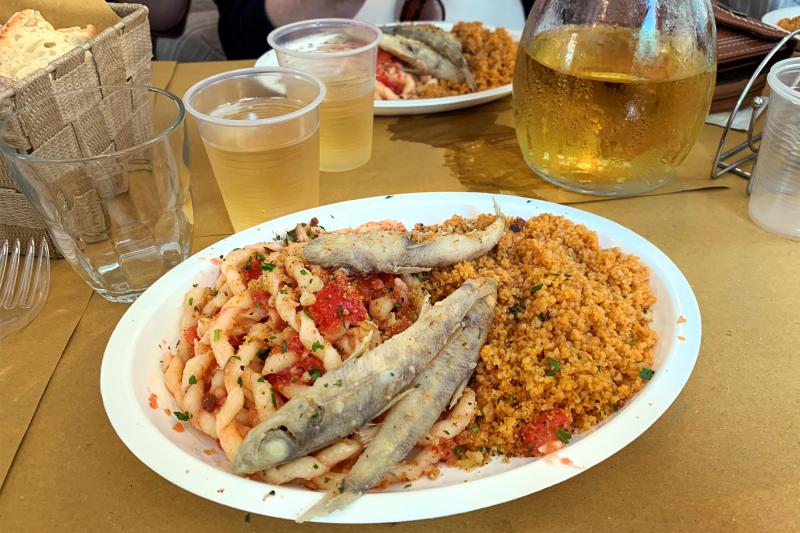Sicilian taste treats
Appears in the Online Edition, July 2020.
Although we've had to postpone European trips because of the pandemic, I believe a weekly dose of travel dreaming can be good medicine. I recall my visit to Sicily a couple of years ago as a parade of delightful meals, each filled with seasonal and local treats infused with the taste of this island's history.
While food may be an art form in Italy, it’s more like a religion in Sicily. Even if you know Italian food well, Sicilian cuisine will surprise you with its complexity—a legacy of successive waves of settlers and invaders who influenced the cuisine.
Choosing between fish couscous and spaghetti Bolognese on the same menu, you know you’re at a crossroads of cultures. Thanks to centuries of North African and Middle Eastern influences, Sicilian cuisine includes distinctive ingredients such as couscous, almonds, ginger, apricots, cinnamon, and lots of citrus. Arabs who came here popularized fried foods, which is why so many Sicilian street food classics—and even some pastas—are deep-fried. Sicilian cooking also comes with Greek and Spanish touches.
The Sicilian diet relies on Italian staples such as pastas, olives, and tomatoes, but with a local twist. The island’s warm temperatures and fertile volcanic soil mean that everything from citrus to nuts are available home-grown. Produce is fresh, cheap, and plentiful—and sold at markets that more closely resemble an Arab souk than a European marketplace. Seafood is abundant.
One of the most memorable ways to eat in Sicily is also one of the cheapest: street food, especially in Sicily's capital, Palermo. Ballarò Market, dating to the 10th century, is the most authentic. Vendors here still maintain the Arab tradition of calling out to passersby in a singsong way, like an auctioneer. Food carts are scattered among the stalls, selling panelle (chickpea fritters), sfincione (fluffy pizza with anchovies), potato croquettes, and lots of other eats. The most popular items are the arancine, deep-fried rice balls with meat sauce inside, which are flavored with vivid yellow saffron and contain no tomatoes. (Sicily's second city, Catania, and mainland Italy call this dish arancino and add tomato to the filling—two things a Palermo native wouldn't be caught dead doing.)
You'll find food specialties all over Sicily. Trapani, on the west coast, is geographically and culturally the island’s closest point to Africa—and the best place to try couscous al pesce, couscous served with a side of fish broth that you ladle on to taste. Fancier variations are topped with shellfish and other seafood.
In Modica, in the southeast, try the grainy, bittersweet cioccolato di Modica. Sicily was under Spanish rule just as explorers were returning from the New World with exotic new foods, including cocoa beans. Modica mastered this new ingredient, crushing it on basalt plates and adding local sugar, creating an early version of chocolate bars.
In Catania, on Sicily's eastern shore at the base of Mount Etna, quench your thirst with a seltz e limone (seltz, for short)—fresh-squeezed lemon juice with seltzer water. They’ll ask you “sale?” to see if you want salt added. (It may sound strange, but a little salt makes this brew exceptionally thirst-quenching.)
Sicily also has its own pasta dishes. Anelletti al forno is ring-shaped pasta, baked with tomatoes, meat, eggplants, and cheese. Busiate alla Trapanese is a twisty noodle topped with red pesto made from almonds, tomatoes, garlic, and basil. Pasta alla Norma, named for an opera by Catania-born composer Vincenzo Bellini, is made with fried eggplants, tomato sauce, basil, and salted ricotta cheese on top. A top-end choice for those who enjoy a taste of the sea is spaghetti ai ricci, spaghetti topped with sea urchin.
Wine has been produced on the shores of Sicily since the time of the Greeks. The island, whose various grape-growing areas have their own distinctive characteristics, is one of Italy's biggest wine producers. Some of the grapes grown here, such as the red nerello grape, can be found only in Sicily. Western Sicily is best known for its Marsala wine, and the Mount Etna area has become a magnet for boutique wine producers due to the rich volcanic soil and old vines. Wineries cluster around the north slope, like a Sicilian Napa Valley.
Sicilian desserts are also distinctive and delicious, most made with a combination of sugar, almonds, citrus, and ricotta. The island's most famous and best sweets are cannoli. A crispy fried pastry tube is filled with sweetened ricotta, then dusted with powdered sugar. The mark of a high-quality cannolo is one that’s filled right when you order it—otherwise, the shell gets soggy and loses its crunch. After tasting cannoli at a Sicilian pastry shop, I know why they say, “Holy cannoli.”
One thing is certain about Sicily: For locals, the food can be a religious experience.
(Rick Steves (www.ricksteves.com) writes European guidebooks, hosts travel shows on public TV and radio, and organizes European tours. This article was adapted from his new book, For the Love of Europe. You can email Rick at rick@ricksteves.com and follow his blog on Facebook.)


